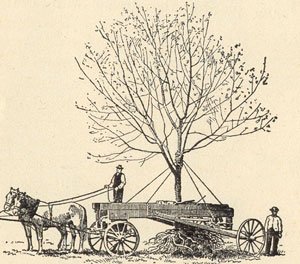
Gardeners threw out their sticky cans of pruning paint after learning that sealing tree wounds with the paint increased the risk of insect and disease infestations, and the trees healed faster without it.
When research showed that planting new trees in deep holes, backfilled with heavily enriched, amended soil actually hindered new roots from growing into the surrounding native soil, we used less compost and manure but dug wider, shallow holes.
Another tree-care myth that needs to be re-considered is the long-held tradition of staking all newly planted trees.
Research shows that most young trees will grow into stronger specimens without staking. Staking limits trunk movement, and it’s this movement that triggers the tree to grow primary (elongation) and secondary (thickening) roots.
A staked tree may grow more rapidly than one left unstaked, but it won’t have as sturdy a root system—much more important for the long-term health of a tree than a quick growth spurt. This explains why some pampered trees that finally do have their straight jackets removed keel over during the first strong wind storm.
Two other reasons to forgo stakes: staked trees are slow to develop a root collar (a trunk that flares out at the bottom also helps stabilize a tree) and support ties can restrict the movement of water, sugars and nutrients in the vascular tissues under the bark. (Not as devastating as the damage from too-tight ties or narrow, sharp ties that cut into bark, but undesirable, nonetheless.)
However, there are instances when staking does make sense:
- Extremely windy sites.
- High-traffic areas where a tree might get knocked about by passersby.
- Very large trees with broad canopies.
If you do decide to stake, here are some guidelines:
- Use two 2 X 2s and drive them 18 inches (13 centimetres) below ground, outside the rootball (preferably in undisturbed soil). Position the stakes so the tree trunk can move with the prevailing winds.
- Make sure stakes are no taller than one-third the height of the trunk to allow the top two-thirds of the tree to move.
- Use broad, smooth ties and leave a bit of slack. The aim is to keep the tree from falling over or settling at an angle — some movement is good.
- Remove stakes and ties after one year.
More about tree planting
Plant a tree at the right depth
How to plant a tree
Using trees to screen
